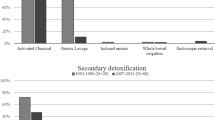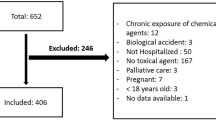Abstract
Case management of adult patients with acute poisoning in a university-based emergency department to determine the factors that affect duration of hospital stay was assessed. In this survey, data were obtained for the period between January 1, 1997 and December 31, 2002 at the emergency department (ED). Case analyses of 2229 patients older than 14 years of age were reviewed. Of all patients, 725 (32.5%) were male, 801 (35.9%) were younger than 20, and 540 (24.2%) were older than 30 years. Mean ages of patients were 29.3±13.2 for the males and 23.8±9.6 for the females (P< .001). During the study, the greatest number of patients were admitted in May (11.0%). Suicidal poisoning was the observed etiology in the majority of cases (76.4%). Moreover, the mortality rate due to poisoning was 3.9%. Drug ingestion was the most frequent means of poisoning (59.0%), followed by pesticides (19.0%). The rate of poisoning with multiple drugs has declined over time, whereas the rate owing to psychoactive drugs has increased markedly. The mean length of hospital stay was 2.9±1.8 days and the proportion of patients who stayed for longer than 2 days was 44.3%. The mean length of hospital stay was longer for males, those older than 30 years, those who had been poisoned unintentionally, and for confused and unconscious patients and those who had arrived to ED more than 2 hours after the event. This study suggests that morbidity for adult patients with poisoning varied by sex, age, and season. Length of hospital stay was affected by sex, age, arrival time to ED, mode of transport, severity of poisoning, and type of agent.
Similar content being viewed by others
References
Höjer J, Baehrendtz S, Gustafsson L. Benzodiazepine poisoning experience of 702 admissions to an intensive care unit during a 14 year period.J Intern Med. 1989;226:117–122.
Hanssens Y, Deleu D, Taqi A. Etiologic and demographic characteristics of poisoning: a prospective hospital based study in Oman.J Toxicol Clin Toxicol. 2001;39:371–380.
Özköse Z, Ayoglu F. Etiological demographical characteristics of acute adult poisoning in Ankara, Turkey.Human Toxicol. 1999;18:514–518.
Health Ministry of Turkey, Department of Statistics. Available at: http://www.saglik.gov.tr/sb/ default.asp?sayfa=ozelistatistik. Accessed October 2003.
Pinar A, Fowler J. Acute poisoning in Izmir, Turkey-a pilot epidemiological study.J Toxicol Clin Toxicol. 1993;31:593–601.
Karakaya A, Vural N. Acute poisoning admissions in one of the hospitals in Ankara.Human Toxicol. 1985;4:323–326.
Litovitz TL, Clark LR, Soloway RA. 1993 Annual report of the American Association of Poison Control Centers Toxic Exposure Surveillance System.Am J Emerg Med. 1994;12:546–584.
Goksu S, Yildinm C, Koçoglu H, Tutak A, Öner U. Characteristics of acute adult poisoning in Gaziantep, Turkey.J Toxicol Clin Toxicol. 2002;40:833–837.
Meredith TJ. Epidemiology of poisoning.Pharmacol Ther. 1993;59:251–256.
Hanssensy Y, Deleu D, Tagi A. Etiologic and demographic characteristics of poisoning: a prospective hospital-based study in Oman.J Toxicol Clin Toxicol. 2001;39:371–380.
Polewka A, Pach J, Zieba A, et al. A trial for the complex risk assessment of repeated suicide predictors in patients after suicidal poisoning attempts, hospitalized in department of clinical toxicology in Krakow.Przegl Lek. 2001;58:325–329.
Schapira K, Linsley KR, Linsley A, et al. Relationship of suicide rates to social factors and availability of lethal methods: comparison of suicide in Newcastle upon Tyne, 1961–1965 and 1985–1994.Br J Psychiatry. 2001; 178:458–464.
Sellers EM, Marshman JA. Acute and chronic drug/abuse emergencies in metropolitan Toronto.Int J Addict. 1981;16:283–303.
Townsend E, Hawton K, Harriss L, Bale E, Bond A. Substances used in deliberate self-poisoning 1985–1997: trends and associations with age, gender, repetition and suicide intent.Soc Psychiatr Epidemiol. 2001;36:228–234.
Guthrie E, Kapur N, Mackway-Jones K, et al. Randomised controlled trial of brief psychological intervention after deliberate self poisoning.BMJ. 2001;323(7305):135–138.
Shiqing Z, Guandg Q, Zhenglong P, Tiensen P. The sex ratio of suicide rates in China.Crisis. 1994; 15:44–48.
Pandey R. The etiology of suicide in India.Indian J Soc Wrk. 1985;45:429–439.
Yusuf HR, Akhter HH, Rahman MH, Chowdhury MK, Rochat RW. Injury-related deaths among women aged 10–50 years in Bangladesh, 1996–97.Lancet. 2000;355:1220–1224.
Pandey R. Suicide and social structure in India.Soc Defense. 1986;21:5–29.
Doganay Z, Sunter AT, Guz H, et al. Climatic and diurnal variation in suicide attempts in the ED.Am J Emerg Med. 2003;21:271–275.
Peter JV, Cherian AM. Organic insecticides.Anaes Int Care. 2000;28;ll-21.
Hawton K, Fagg J. Trends in deliberate self-poisoning and self injury in Oxford, 1976–1990.BMJ. 1992;304:1409–1411.
Lamminpaa A, Riihimaki V, Vilska J. Hospitalizations due to poisoning in Finland.J Clin Epidemiol. 1993;46:47–55.
Hettiarachchi J, Kodithuwakku GCS. Pattern of poisoning in rural Sri Lanka.Int J Epidemiol. 1989;18:418–422.
Eddleston M, Karaliedde L, Buckley N, et al. Pesticide poisoning in the developing world—a minimum pesticide list.Lancet. 2002;360:1163–1167.
Joubert PH. Poisoning admissions of black South Africans.Clin Toxicol. 1990;28:85–94.
Thomas SHL, Lewis S, Bevan L, et al. Factors affecting hospital admission and length of stay of poisoned patients in the north east of England.Hum Exp Toxicol. 1996;15:915–919.
Author information
Authors and Affiliations
Rights and permissions
About this article
Cite this article
Satar, S., Seydaoglu, G. Analysis of acute adult poisoning in a 6-year period and factors affecting the hospital stay. Adv Therapy 22, 137–147 (2005). https://doi.org/10.1007/BF02849884
Issue Date:
DOI: https://doi.org/10.1007/BF02849884




